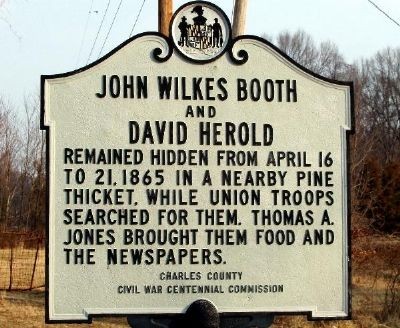Pine Thicket
Introduction
Text-to-speech Audio
Images
Near this marker, Booth and Herold sacrificed their horses, despite Booth's broken leg, to avoid capture by Union soldiers. The horses could be heard outside the thicket, so Herold led them into a swamp and shot them. (Photo source: HMdb.org.)

Backstory and Context
Text-to-speech Audio
The "pine thicket" is located at Rich Hill in what is now called Bel Alton, Maryland. The marker is located at the intersection of Bel Alton Newtown Road and Wills Road.
John Wilkes Booth and David Herold were part of a plan to assassinate the top three executive officials of the U.S. government for the purpose of punishing the Union for its “aggression” against the Southern States and to allow the installation of more Confederate-leaning politicians. Booth had slain President Lincoln on April 14, 1865 at Ford’s Theater. Herold wounded but failed to slay Secretary of State William Seward. The two fled the nation’s capitol fleeing south to southern Maryland where Confederate sympathizers were expected to greet them as heroes.
On April 16, Booth and Herold arrived at Rich Hill, the home of Confederate sympathizer Colonel Samuel Cox. The two fugitives were given food and a place to sleep, but Cox’s home was too well known. Cox led the two men into a ‘pine thicket’ where they would wait for another sympathetic smuggler, neighbor Thomas Jones. Jones hid the men in a patch of woods near his house, giving them food and other aid. There Booth and Herold waited four and a half days until they got passage across the Potomac River. Cox was later convicted for assisting Booth’s escape.
Booth and Herold were not safe in the woods near Jones’s home. Soldiers were passing by too closely and Jones, fearing the horses might betray their position, instructed Herold to dispose of them. Herold led his horses into a nearby swamp concealed by pine trees and shot them. After four and a half days, Jones took the fugitives to Dent’s Meadow where they use one of Jones’s boats to cross the Potomac. They made their crossing but were unaware that they had been spotted by a colored man who reported them.
